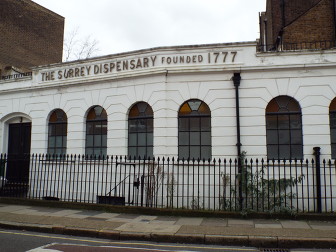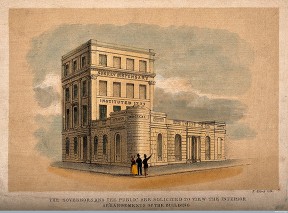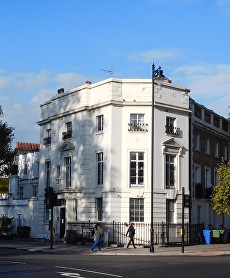





Exploring Southwark and discovering its history


The Surrey Dispensary
This attractive early 19th century building on the corner of Falmouth Road and Trinity Street bearing the lettering ‘The Surrey Dispensary founded 1777’ is Grade II listed. It has been a private residence since 1971 and the people who have lived there include Mai Zetterling and Sam Wannamaker (or so estate agents details tell us). It represents a bit of history as the Surrey Dispensary was one of the earliest charitable dispensaries to open in London to treat the poor.

The Dispensary’s first premises were in Montague Close close to St Saviour’s Church (now Southwark Cathedral) and a prospectus was prepared to raise subscriptions. Its first paragraph stated:
"As the poor constitute an important part of every large community, they justly merit the attention and assistance of the rich, especially in sickness when they are rendered incapable of supporting themselves and their families. Hard, labour, unwholesome food, want of proper clothing, and exposure to the vicissitudes of air and weather, subject them to many disorders unknown to those whose affluence can procure the conveniences of life”.
To be seen at the Dispensary, a patient needed a letter of recommendation from a Governor. Everyone who subscribed one guinea a year was entitled to be a Governor and to have one patient on the medical and surgical list, and one patient needing the services of a mid-wife. The number of patients a Governor could recommend increased in proportion to the money subscribed. Patients too ill to attend in person at the Dispensary and who resided within the stipulated area were visited in their own homes by a physician.
The Dispensary moved to premises in Union Street in 1784, next door to the newly built Union Hall. Attached to the Dispensary there were now three physicians, two surgeons, one apothecary and a number of midwives. In the year 1821, the Dispensary saw 4,195 patients, of which 1,398 were seen in their homes and 548 were midwifery cases. Nearly 30 years later, in 1849, reflecting a rapidly rising population, the Dispensary saw 5,617 patients, of which 983 were seen at home and 477 were midwifery patients. Perhaps surprisingly, the number of midwifery patients had decreased.

By 1839, the premises in Union Street had become too small and also the lease, which was held from St Batholomew's Hospital, was due for renewal. The Dispensary moved to Great Dover Street (see right) in 1840 where they stayed until 1927 when the Dispensary moved to the building we now know as the Surrey Dispensary at the corner of Falmouth Road and Trinity Street. I have been unable to find out when the Surrey Dispensary closed its doors to patients, perhaps when the National Health Service was formed in 1947, though it still exists as a small charity that awards grants to residents of North Southwark who are in need through sickness.

To meet the needs of a growing population, the South London Dispensary opened in 1821.Speaking at an Anniversary Dinner over 20 years later, the president at that time, William Denison, recalled that when the charity was first established, it was located in a rented house that was "inconveniently small." Nevertheless, during the first month the Dispensary saw 122 patients. 20 years later the number had increased to about 5,000 per annum and a new building was erected opposite Bethlem Hospital (now the Imperial War Museum). The Duke of Cambridge lay the foundation stone and Queen Victoria was also a patron of what had now become the Royal South London Dispensary.

Annual fund-raising dinners were held and anniversary sermons were preached to bring in donations but nearly one hundred years after its foundation, in common with many charitable institutions in the First World War, the Dispensary was forced to close in 1917 for lack of financial support. The building is now the Elizabeth Baxter Hostel, a hostel for the homeless.